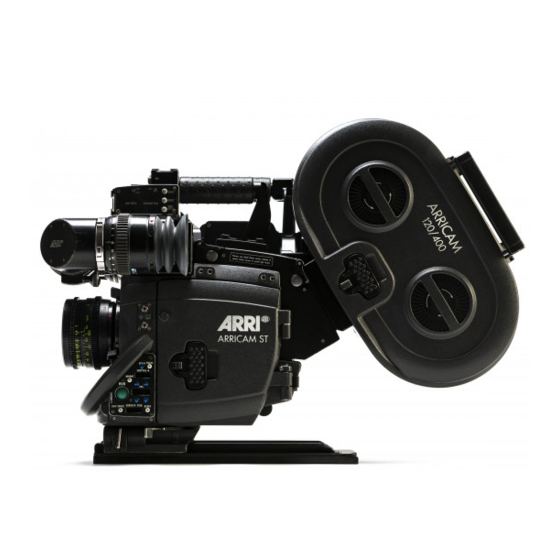Table of Contents
Advertisement
Quick Links
Download this manual
See also:
User Manual
Advertisement
Table of Contents

Summary of Contents for ARRI ARRICAM Studio
-
Page 1: Table Of Contents
ARRICAM Studio Quick Guide About, Software, Tools, Safety Camera Left & Front Camera Right & Back Camera Top and Base Viewfinder Overview Quick Specs Messages & Warnings Basic Camera Operations Magazine Overview Magazine Configurations Loading Studio Magazines Threading Integrated Video System... -
Page 2: Arricam Studio
This page is left blank intentionally. ARRICAM Studio Quick Guide 01/2004, Page 2 of 20... -
Page 3: About, Software, Tools, Safety
About, Software, Tools, Safety About ARRICAM Quick Guides This Quick Guide (order number K5.58311.0) provides a short introduction to the ARRICAM Studio. Further Quick Guides are dedicated to the ARRICAM Lite (K5.58312.0) and ARRICAM Accessories (K5.58313.0). An overview of all ARRICAM components, a cable overview and Ground Glass overview, is given in the ARRICAM System Guide (K5.58314.0). -
Page 4: Camera Left & Front
1 = normal 35 Integrated Video System 2 = super 35 Beeper volume control Lens Data System contacts DUST CHECK button Field lens RS connectors (Remote RUN & 24 V dc) Ground Glass ARRICAM Studio Quick Guide 01/2004, Page 4 of 20... -
Page 5: Camera Right & Back
Tape hook Image rotation knob Integrated Video System Manual Control Box Image rotation lock port cover Eyepiece rotation Camera Accessory friction Connector (CAC) Tape hook Power connector (BAT) Power on/off switch ARRICAM Studio Quick Guide 01/2004, Page 5 of 20... -
Page 6: Camera Top And Base
Image rotation knob Eyepiece 3/8”-16 mounting holes Viewfinder Image rotation Hole for Shoulder lock Pad locating pin Cover for Power Shoulder Pad Bridgeplate contacts mounting hole Power on/off Studio Camera switch Handle ARRICAM Studio Quick Guide 01/2004, Page 6 of 20... -
Page 7: Viewfinder Overview
Studio Integrated Video System (IVS) Studio Readout Studio 100% Video Top Studio Mask Studio LCD Frameglow Frameglow Studio Eyepiece Eyecup Studio Anamorphic Extension Studio Zoom Extension Lite Universal Eyepiece Heated Eyecup Studio Medium Extension ARRICAM Studio Quick Guide 01/2004, Page 7 of 20... -
Page 8: Quick Specs
Mode Set, Ground Glasses, Aperture Format Masks, PL mount lenses, Shift & Tilt system, Matte Boxes, Follow Focus systems, Right Camera Handgrip with RUN/ STOP button, batteries, power supplies, ARRI Dovetail system, Arrihead 2. ARRICAM Studio Quick Guide 01/2004, Page 8 of 20... -
Page 9: Messages & Warnings
PHASE button. In either condition, check the shutter angle manually and proceed with caution as exposure may be incorrect. Consult an ARRI Service Center. The primary shutter signal and preset shutter angle differ. If running, the camera stops and will not restart. -
Page 10: Basic Camera Operations
The following messages might be shown: Controlling item Controlling item Standard Camera Control Panel -SCB Speed Control Box (reverse run) Extended Camera Control Panel Wireless Remote Control 24.0 ARRICAM Studio Quick Guide 01/2004, Page 10 of 20... - Page 11 Manual Control Box is attached to the camera, its MANUAL CONTROL switch has to be set to OFF or to FPS. If the SCB is attached to the camera, make sure that its COMPENSATION switch is set to OFF or to IRIS. ARRICAM Studio Quick Guide 01/2004, Page 11 of 20...
-
Page 12: Magazine Overview
Magazine Overview Top Load Adapter Studio Magazine 300/1000 Dual Port Adapter ARRICAM Studio Studio Magazine 120/400 Back Load Adapter Lite Shoulder Magazine Lite Mag to Studio Camera Adapter Lite Steadicam Magazine ARRICAM Studio Quick Guide 01/2004, Page 12 of 20... -
Page 13: Magazine Configurations
ARRICAM Studio. Mounting Studio Magazines There are three possible positions to mount Studio magazines on the ARRICAM Studio: 1. Top mounted with the Top Load Adapter or with the Dual Port Adapter e.g. for use with a geared/fluid head. -
Page 14: Loading Studio Magazines
Lift the film up from the coreholder, turn it and push down again. Note: When placing film on the feed side coreholder, do not push on the film itself, as it could become conical. ARRICAM Studio Quick Guide 01/2004, Page 14 of 20... - Page 15 PHASE button. Note: Always make sure that a loop protector is on the magazine when it is not on the camera. ARRICAM Studio Quick Guide 01/2004, Page 15 of 20...
-
Page 16: Threading
• When you feel the transport claws touch the film, slide the film a little up and down so that the transport claws engage the film perforations. Lock the movement by turning the locking lever fully counter-clockwise. ARRICAM Studio Quick Guide 01/2004, Page 16 of 20... - Page 17 Note: When using the Dual Port Adapter, remember to cover the unused port with the Dual Port Adapter cover. Back Load Adapter Lite Mag to Studio Camera Adapter Dual Port Adapter Top Load Adapter back mounted ARRICAM Studio Quick Guide 01/2004, Page 17 of 20...
-
Page 18: Integrated Video System
Since the Automatic Gain Control averages the image brightness, in some lighting situations e.g. strong back light or if the video image is still too dark, the Manual Gain Control will yield a better video image. ARRICAM Studio Quick Guide 01/2004, Page 18 of 20... - Page 19 Varying degrees of motion blur can be achieved by changing fps, shutter angle, lighting contrast and the speed of object and camera movement. Motion blur is most visible at slow fps and wide open shutter angles (e.g. 6 fps and 180° ARRICAM Studio Quick Guide 01/2004, Page 19 of 20...
-
Page 20: Arri Group Addresses
CSC Camera Service Center (Film Equipment Rental, Florida) 2385 Stirling Road, Fort Lauderdale, FL 33312, USA Voice phone: +1 954 322 4545, FAX: +1 954 322 4188 Email: estamm@cameraservice.com World Wide Web www.arri.com ARRICAM Studio Quick Guide 01/2004, Page 20 of 20...

















Need help?
Do you have a question about the ARRICAM Studio and is the answer not in the manual?
Questions and answers